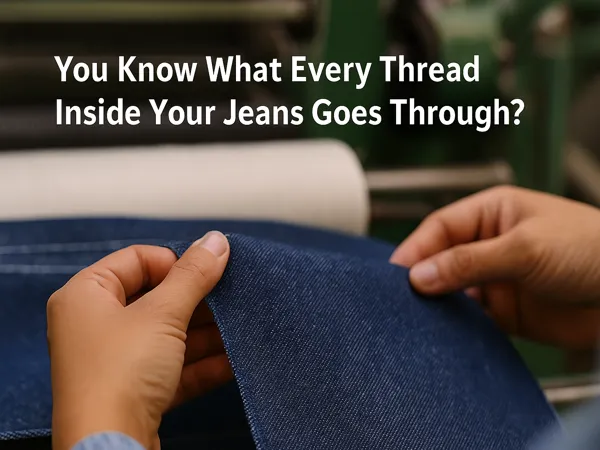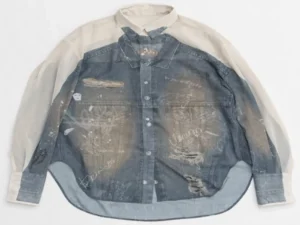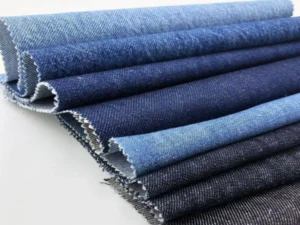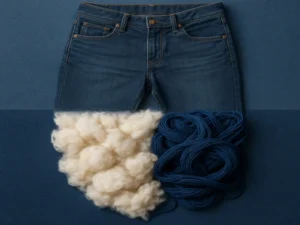Most people don’t think about the thread inside their jeans. They care about the fit, the wash, maybe the brand. But every day, when you bend your knees, sit down, or throw on a pair of jeans for work or a weekend outing, something incredible is happening—millions of tiny fibers are working under pressure, held together by one clever invention: twist.
This isn’t just a detail in textile production. It’s the reason your jeans don’t fall apart.
Let’s learn the story of yarn twisting: why it’s done, why it’s important, and what’s inside each yarn that touches your skin.
It is divided into the following points:
- Watching Yarn Twist for the First Time
- The Yarn-Twisting Process: Step by Step
- Why Twisting Makes Yarn Stronger
- How Much Twist Is Too Much?
- What Twist Means for Denim
- The Innovation of Cloud Soft Yarn
- Real-World Stress: What Happens When You Wear Jeans
- When Twist Goes Wrong
1. Watching Yarn Twist for the First Time
Imagine a cotton fiber being spun into yarn for the first time. It starts out like a cloud—soft, airy, and easy to pull apart. But then the machine starts to work, and the fibers begin to entwine, spinning around each other in a tight spiral that gets stronger with each rotation.
By the end of the process, the once loose and brittle part has become as elastic as a rope. It’s this simple, mechanical twist that gives the yarn its tension, structure, and resistance to breaking when put under pressure.
2. The Yarn-Twisting Process: Step by Step
Twisting isn’t an afterthought—it’s built into the spinning process. Here’s how it works, step by step:

Drafting – fibers are pulled and aligned.
Twisting – machines rotate the strand to create cohesion.
Winding – twisted yarn is collected on cones or bobbins.
S-twist and Z-twist refer to the direction of twist; Z-twist is more common in denim.
3. Why Twisting Makes Yarn Stronger
Twist isn’t just decorative—it’s physics. Twist binds fibers together so they grip and resist being pulled apart.
Think of braiding rope or twisting paper—tight turns equal strength. Twisted yarns survive weaving, dyeing, and daily wear without breaking.
4. How Much Twist Is Too Much?
Different levels of twist produce different results:
– Low twist: soft but weak
– Medium twist: balanced for denim and casual fabrics
– High twist: strong but stiff
Twist Multiplier (TM) helps spinners fine-tune strength vs. softness.
5. What Twist Means for Denim
Medium-twist yarns are ideal for denim—they balance strength with comfort. Twist affects durability, stretch, and how fabric fades.
Tighter twist: slower fading, more structure. Looser twist: faster wear-in, softer feel.
6. The Innovation of Cloud Soft Yarn
Cloud Soft Yarn is an engineered yarn system used in modern denim. It’s designed to:
– Feel soft like combed cotton
– Stretch and recover beautifully
– Minimize shrinkage after wash

It achieves this by combining the right fiber blend with calibrated twist levels.
7. Real-World Stress: What Happens When You Wear Jeans
Everyday motion—sitting, stretching, bending—puts yarns under constant tension. Twisted yarns distribute this pressure evenly across the fabric structure, preventing breakage or distortion.
8. When Twist Goes Wrong
Too much twist can make yarn stiff, wiry, or hard to dye. Too little twist causes fuzz, pilling, or breakage.
Yarn twist must be optimized for end use—comfort, durability, and processability all depend on it.
Conclusion: The Twist That Holds It All Together
Yarn twist is an invisible force behind the durability of every pair of jeans. It’s what lets fabric stretch, return, and stay together wash after wash.
Next time you pull on your jeans, remember: it’s not just cotton—it’s engineering in every twist.
ZEVA DENIM: Where Twist Meets Innovation
If you’re looking for denim fabrics that are engineered with purpose—from fiber selection to twist and finish—ZEVA DENIM is a trusted resource for designers and brands worldwide.
As a leading denim fabric manufacturer in China, ZEVA DENIM integrates R&D, production, and marketing to offer over 200+ classic and innovative denim fabrics—including advanced yarn systems like Cloud Soft Yarn.
With:
– Small minimum order quantities (MOQ)
– Fast delivery (typically within 7 days)
– Responsive technical support
– A product range that includes rigid, stretch, selvedge, and eco-conscious fabrics





